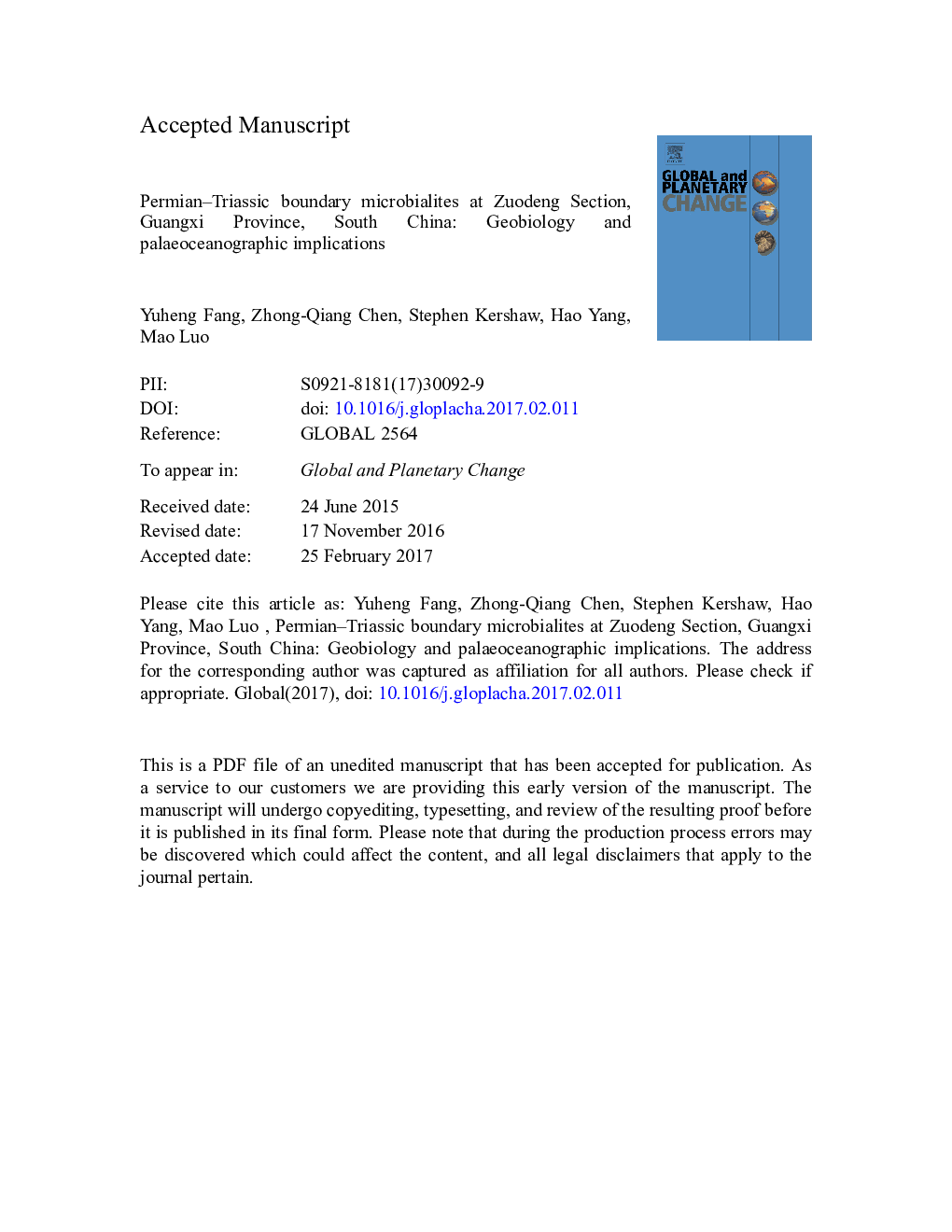| کد مقاله | کد نشریه | سال انتشار | مقاله انگلیسی | نسخه تمام متن |
|---|---|---|---|---|
| 5755338 | 1621630 | 2017 | 48 صفحه PDF | دانلود رایگان |
عنوان انگلیسی مقاله ISI
Permian-Triassic boundary microbialites at Zuodeng Section, Guangxi Province, South China: Geobiology and palaeoceanographic implications
دانلود مقاله + سفارش ترجمه
دانلود مقاله ISI انگلیسی
رایگان برای ایرانیان
کلمات کلیدی
موضوعات مرتبط
مهندسی و علوم پایه
علوم زمین و سیارات
فرآیندهای سطح زمین
پیش نمایش صفحه اول مقاله

چکیده انگلیسی
A previously unknown microbialite bed in the Permian-Triassic (P-Tr) boundary beds of Zuodeng section, Tiandong County, Guangxi, South China comprises a thin (5Â cm maximum thickness) stromatolite in the lower part and the remaining 6Â m is thrombolite. The Zuodeng microbialite has a pronounced irregular contact between the latest Permian bioclastic limestone and microbialite, as in other sites in the region. The stromatolite comprises low-relief columnar and broad domal geometries, containing faint laminations. The thrombolite displays an irregular mixture of sparitic dark coloured altered microbial fabric and light coloured interstitial sediment in polished blocks. Abundant microproblematic calcimicrobe structures identified here as Gakhumella are preserved in dark coloured laminated areas of the stromatolite and sparitic areas in thrombolites (i.e. the calcimicrobial part, not the interstitial sediment) and are orientated perpendicular to stromatolitic laminae. Each Gakhumella individual has densely arranged segments, which form a column- to fan-shaped structure. Single segments are arch-shaped and form a thin chamber between segments. Gakhumella individuals in the stromatolite and thrombolite are slightly different from each other, but are readily distinguished from the Gakhumella- and Renalcis-like fossils reported from other P-Tr boundary microbialites in having a smaller size, unbranching columns and densely arranged, arch-shaped segments. Renalcids usually possess a larger body size and branching, lobate outlines. Filament sheath aggregates are also observed in the stromatolite and they are all orientated in one direction. Both Gakhumella and filament sheath aggregates may be photosynthetic algae, which may have played an important role in constructing the Zuodeng microbialites. Other calcimicrobes in the Zuodeng microbialite are spheroids, of which a total of five morphological types are recognized from both stromatolite and thrombolite: (1) sparry calcite spheroid without outer sheaths, (2) a large sparry calcite nucleus coated with a thin sparry calcite sheath, (3) a large nucleus of micrite framboid aggregates rimmed by a thin sparry calcite sheath (bacterial clump-like spheroids), (4) a large nucleus of micrite framboid aggregates coated with a thin micritic sheath, and (5) a small sparry nuclei rimmed by coarse-grained, radiated euhedral rays. The irregular contact beneath the Zuodeng microbialites is interpreted as a subaerial exposure surface due to regional regression in South China. The demise of the Zuodeng microbialites may have been due to rapid rise in sea-level because they grew in relatively shallow marine conditions and are overlain by muddy limestones containing pelagic conodonts. Also siliciclastic content increases above the microbialite, suggesting a possible climate-related increase in weathering as the transgression progressed.
ناشر
Database: Elsevier - ScienceDirect (ساینس دایرکت)
Journal: Global and Planetary Change - Volume 152, May 2017, Pages 115-128
Journal: Global and Planetary Change - Volume 152, May 2017, Pages 115-128
نویسندگان
Yuheng Fang, Zhong-Qiang Chen, Stephen Kershaw, Hao Yang, Mao Luo,